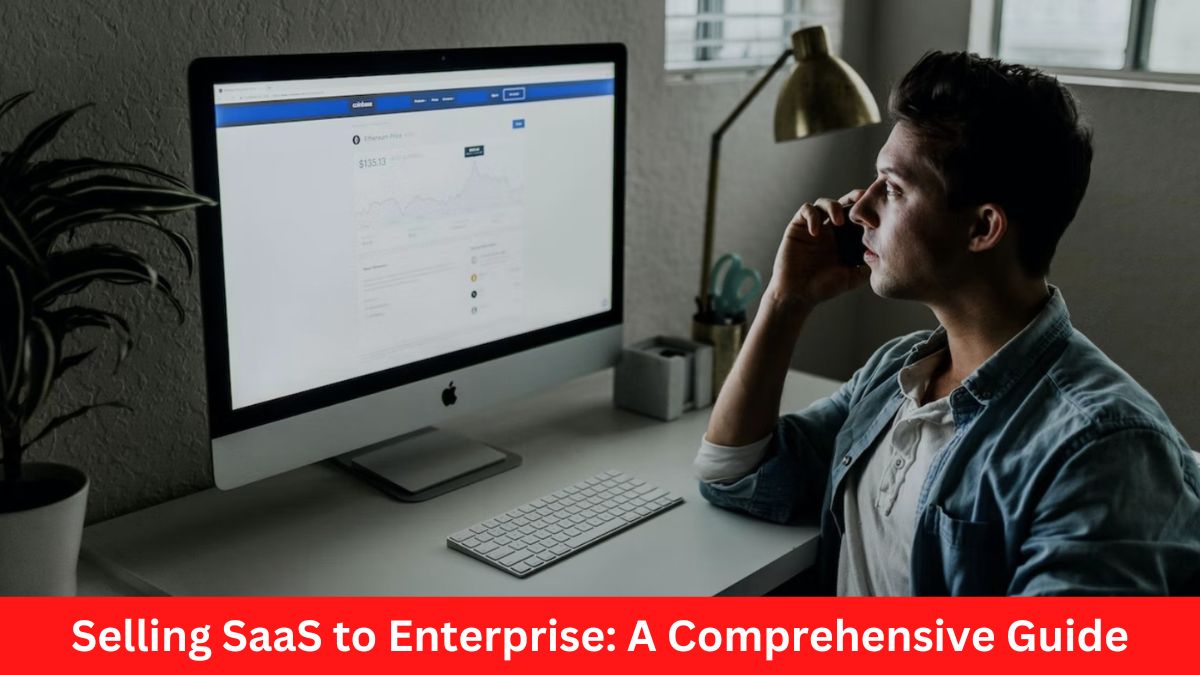As the world becomes increasingly digital, more and more enterprises are turning to Software-as-a-Service (SaaS) to streamline their operations. However, selling SaaS to enterprise customers is no easy feat.
This guide will break down the process into MECE (Mutually Exclusive, Collectively Exhaustive) subheadings to help you effectively sell your SaaS solution to enterprise customers.
Understanding the Enterprise Market
Selling SaaS solutions to enterprise customers requires a deep understanding of the market and its unique characteristics. In this section, we’ll cover the definition of the enterprise market, the characteristics of enterprise customers, the size of the market, and the latest market trends and predictions.
Definition of the Enterprise Market
The enterprise market refers to companies with more than 1,000 employees, a high level of revenue, and complex business processes. These companies have specific needs and challenges that require specialized software solutions, including enterprise resource planning (ERP), customer relationship management (CRM), human resources management (HRM), and supply chain management (SCM).
Characteristics of Enterprise Customers
Enterprise customers have different needs and requirements than consumers or small businesses. These customers are typically more risk-averse and require secure, reliable, and scalable solutions. They also need software customized to their specific needs and integrated with their IT infrastructure.
Additionally, enterprise customers often have a longer decision-making process that involves multiple stakeholders and decision-makers. They require high support and customer service throughout the buying process and implementation.
Size of the Enterprise Market
The enterprise market size is significant, with millions of potential customers worldwide. According to Grand View Research, the global enterprise software market size was valued at
$389.3 billion in 2020 is expected to grow at a compound annual growth rate (CAGR) of 7.5% from 2021 to 2028.
Market Trends and Predictions
The enterprise software market is constantly evolving, and staying up-to-date with the latest trends and predictions is essential. Here are some of the most significant trends in the enterprise software market:
- Cloud-Based Solutions: More and more enterprise customers are adopting cloud-based solutions, as they offer greater flexibility, scalability, and cost-effectiveness.
- Artificial Intelligence (AI) and Machine Learning (ML): AI and ML are increasingly integrated into enterprise software solutions, providing greater automation and data-driven insights.
- Mobile-First Solutions: With more employees working remotely, enterprise customers seek solutions accessible on mobile devices, including smartphones and tablets.
- Industry-Specific Solutions: As enterprise customers have unique needs depending on their industry, software vendors are developing industry-specific solutions that cater to these needs.
Identifying the Pain Points
To sell your SaaS solution to enterprise customers, it’s essential to identify their pain points and offer solutions that address their specific challenges. In this section, we’ll cover the common
pain points of enterprise customers, tools and techniques for identifying pain points, and strategies for addressing them.
Common Pain Points of Enterprise Customers
Enterprise customers face unique challenges that require specialized software solutions. Here are some of the most common pain points of enterprise customers:
- Legacy Systems: Many enterprise customers have outdated systems that are difficult to maintain, lack integration, and have limited functionality.
- Security: Enterprise customers have sensitive data that needs to be protected from cyber threats, which can cause significant financial and reputational damage.
- Scalability: As enterprise customers grow, they require software solutions that can scale to meet their increasing needs.
- User Adoption: Enterprise customers need software solutions that are easy to use and adopt, as their employees have different levels of technical expertise.
- Integration: Enterprise customers need software solutions that can integrate with their existing IT infrastructure, including other software systems.
 Support: Enterprise customers require high support and customer service throughout the buying process and implementation.
Support: Enterprise customers require high support and customer service throughout the buying process and implementation.
Tools and Techniques for Identifying Pain Points
There are several tools and techniques that you can use to identify the pain points of your enterprise customers. Here are some of the most effective:
- Customer Surveys: Conducting customer surveys can provide valuable insights into the pain points of your enterprise customers.
- Customer Interviews: Speaking with your customers directly can provide in-depth insights into their pain points and challenges.
- Analytics: Analyzing user behavior and data can provide valuable insights into your customers’ pain points.
- Competitor Analysis: Analyzing your competitors can provide insights into their customers’ pain points, which can help you identify similar pain points among your customers.
Strategies for Addressing Pain Points
Once you’ve identified the pain points of your enterprise customers, it’s crucial to offer solutions that address these challenges. Here are some strategies for addressing pain points:
- Customization: Offering customization options can help address pain points related to specific needs and requirements.
- Integration: Offering integration options can help address pain points related to integration with existing IT infrastructure.
- User-Friendly Design: Offering user-friendly software design can help address pain points related to user adoption.
- Security: Offering high-level security features can help address pain points related to data protection.
- Scalability: Offering scalable solutions can help address pain points related to the growth and expansion of enterprise customers.
- Customer Service: Offering a high level of customer service can help address pain points related to support and implementation.
Building a Winning Sales Strategy
To successfully sell your SaaS solution to enterprise customers, it’s essential to have a
well-crafted sales strategy that addresses their pain points and offers compelling solutions. In this section, we’ll cover the key components of a winning sales strategy, including crafting a compelling value proposition, strategies for addressing objections, creating a sense of urgency, and tailoring your pitch to the decision-makers.
Crafting a Compelling Value Proposition
A compelling value proposition is a critical component of a successful sales strategy. It should clearly articulate the unique benefits of your SaaS solution and how it addresses the pain points of your enterprise customers. Here are some tips for crafting a compelling value proposition:
- Identify your unique selling proposition: What sets your SaaS solution apart from your competitors? What unique benefits does it offer?
- Highlight the value of your solution: How will your SaaS solution improve the productivity, efficiency, and profitability of your enterprise customers?
- Use customer testimonials: Including customer, testimonials can help establish credibility and demonstrate the effectiveness of your solution.
Strategies for Addressing Objections
Objections are a common part of the sales process, and addressing them effectively can be the difference between a sale and a missed opportunity. Here are some strategies for addressing objections:
- Listen actively: Listen carefully to your customer’s objections and acknowledge their concerns.
- Address objections head-on: Be prepared to address objections directly and offer solutions that address your customers’ concerns.
- Provide evidence: Use case studies, customer testimonials, and other evidence to support your solution and overcome objections.
Creating a Sense of Urgency
Creating a sense of urgency is an effective strategy for closing deals with enterprise customers. By emphasizing the value of your SaaS solution and the potential consequences of delaying, you can create a sense of urgency and encourage your customers to take action. Here are some tips for creating a sense of urgency:
- Highlight the benefits of taking action: Emphasize the benefits of implementing your solution as soon as possible, such as increased efficiency, productivity, and profitability.
- Showcase the potential consequences of delay: Explain the potential negative consequences, such as lost revenue, reduced productivity, and missed opportunities.
Tailoring Your Pitch to the Decision-Makers

Tailoring your pitch to the decision-makers is crucial to a winning sales strategy. You need to understand the needs and priorities of the decision-makers and craft your pitch accordingly. Here are some tips for tailoring your pitch to the decision-makers:
- Identify the decision-makers: Identify the key decision-makers and understand their roles and priorities.
- Understand their pain points: Understand the pain points of the decision-makers and how your solution can address them.
- Speak their language: Use language that resonates with the decision-makers and their priorities.
Demonstrating Value and ROI
To successfully sell your SaaS solution to enterprise customers, it’s essential to have a
well-crafted sales strategy that addresses their pain points and offers compelling solutions. In this section, we’ll cover the key components of a winning sales strategy, including crafting a compelling value proposition, strategies for addressing objections, creating a sense of urgency, and tailoring your pitch to the decision-makers.
Crafting a Compelling Value Proposition
A compelling value proposition is a critical component of a successful sales strategy. It should clearly articulate the unique benefits of your SaaS solution and how it addresses the pain points of your enterprise customers. Here are some tips for crafting a compelling value proposition:
- Identify your unique selling proposition: What sets your SaaS solution apart from your competitors? What unique benefits does it offer?
- Highlight the value of your solution: How will your SaaS solution improve the productivity, efficiency, and profitability of your enterprise customers?
- Use customer testimonials: Including customer, testimonials can help establish credibility and demonstrate the effectiveness of your solution.
Strategies for Addressing Objections
Objections are a common part of the sales process, and addressing them effectively can be the difference between a sale and a missed opportunity. Here are some strategies for addressing objections:
- Listen actively: Listen carefully to your customer’s objections and acknowledge their concerns.
- Address objections head-on: Be prepared to address objections directly and offer solutions that address your customers’ concerns.
- Provide evidence: Use case studies, customer testimonials, and other evidence to support your solution and overcome objections.
Creating a Sense of Urgency
Creating a sense of urgency is an effective strategy for closing deals with enterprise customers. By emphasizing the value of your SaaS solution and the potential consequences of delaying, you can create a sense of urgency and encourage your customers to take action. Here are some tips for creating a sense of urgency:
- Highlight the benefits of taking action: Emphasize the benefits of implementing your solution as soon as possible, such as increased efficiency, productivity, and profitability.
- Showcase the potential consequences of delay: Explain the potential negative consequences of delaying, such as lost revenue, reduced productivity, and missed opportunities.
Tailoring Your Pitch to the Decision-Makers
Tailoring your pitch to the decision-makers is crucial to a winning sales strategy. You need to understand the needs and priorities of the decision-makers and craft your pitch accordingly. Here are some tips for tailoring your pitch to the decision-makers:
Identify the decision-makers: Identify the key decision-makers and understand their roles and priorities.
- Understand their pain points: Understand the pain points of the decision-makers and how your solution can address them.
- Speak their language: Use language that resonates with the decision-makers and their priorities.
Addressing Security and Compliance Concerns

Addressing Security Concerns:
When addressing security concerns, organizations need to adopt a multi-layered approach. They should implement technical and administrative controls, such as firewalls, intrusion detection and prevention systems, access controls, and security policies and procedures.
Regular security audits, vulnerability assessments, and penetration testing are also essential to identify and address any weaknesses in the security infrastructure.
Organizations should also ensure adequate incident response plans to detect, respond to, and recover from security incidents. These plans should include procedures
for notifying stakeholders, assessing the impact of the incident, containing and mitigating the damage, and restoring the affected systems and data.
Understanding Compliance Requirements:
Organizations must first identify the relevant regulations and standards that apply to their business to understand compliance requirements.
This involves conducting a thorough risk assessment to determine the types of data and systems they handle, the potential threats and vulnerabilities, and the legal and regulatory requirements.
Once they have identified the applicable regulations and standards, organizations should ensure they have the necessary policies, procedures, and controls to comply with them.
This includes data protection measures, retention policies, access controls, and incident response plans. Regular audits and assessments can help organizations identify gaps in their compliance posture and take corrective action.
Obtaining Certifications and Compliance Documentation:
Certification and compliance documentation are essential for organizations that want to demonstrate their commitment to security and compliance. Certifications such as ISO 27001, SOC 2, and PCI-DSS provide third-party validation of an organization’s compliance with industry-recognized standards. These certifications can help build trust and confidence with customers, partners, and regulators.
Conclusion
In conclusion, selling SaaS to enterprise customers can be a lucrative opportunity for software companies.
However, it requires a comprehensive understanding of the enterprise market and its unique challenges and opportunities.
To succeed in this market, organizations must develop a compelling value proposition that addresses the specific needs of enterprise customers, including scalability, security, compliance, and integration. They must also build strong relationships with decision-makers and influencers, navigate legal and procurement departments, and negotiate pricing and contracts that meet the needs of both parties.
At the same time, organizations must continue to innovate and evolve their products and services to meet the changing needs of enterprise customers. By doing so, they can maintain a competitive edge in a rapidly changing market.
By following the guidelines outlined in this article, organizations can successfully sell SaaS to enterprise customers and achieve their business objectives. Whether you’re a startup or an established player, understanding the enterprise market and implementing the best practices can help you achieve long-term success in this exciting and dynamic industry.

